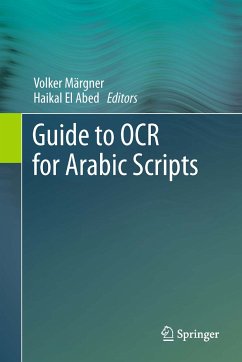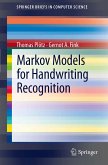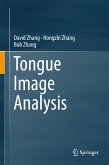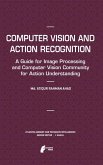Guide to OCR for Arabic Scripts (eBook, PDF)
96,29 €
inkl. MwSt.
Sofort per Download lieferbar
Guide to OCR for Arabic Scripts (eBook, PDF)
- Format: PDF
- Merkliste
- Auf die Merkliste
- Bewerten Bewerten
- Teilen
- Produkt teilen
- Produkterinnerung
- Produkterinnerung

Bitte loggen Sie sich zunächst in Ihr Kundenkonto ein oder registrieren Sie sich bei
bücher.de, um das eBook-Abo tolino select nutzen zu können.
Hier können Sie sich einloggen
Hier können Sie sich einloggen
Sie sind bereits eingeloggt. Klicken Sie auf 2. tolino select Abo, um fortzufahren.

Bitte loggen Sie sich zunächst in Ihr Kundenkonto ein oder registrieren Sie sich bei bücher.de, um das eBook-Abo tolino select nutzen zu können.
This Guide to OCR for Arabic Scripts is the first book of its kind, specifically devoted to this emerging field. Topics and features: contains contributions from the leading researchers in the field; with a Foreword by Professor Bente Maegaard of the University of Copenhagen; presents a detailed overview of Arabic character recognition technology, covering a range of different aspects of pre-processing and feature extraction; reviews a broad selection of varying approaches, including HMM-based methods and a recognition system based on multidimensional recurrent neural networks; examines the…mehr
- Geräte: PC
- ohne Kopierschutz
- eBook Hilfe
- Größe: 18.26MB
- Upload möglich
Andere Kunden interessierten sich auch für
![Markov Models for Handwriting Recognition (eBook, PDF) Markov Models for Handwriting Recognition (eBook, PDF)]() Thomas PlötzMarkov Models for Handwriting Recognition (eBook, PDF)53,49 €
Thomas PlötzMarkov Models for Handwriting Recognition (eBook, PDF)53,49 €![Pattern Recognition and Image Analysis (eBook, PDF) Pattern Recognition and Image Analysis (eBook, PDF)]() Pattern Recognition and Image Analysis (eBook, PDF)91,62 €
Pattern Recognition and Image Analysis (eBook, PDF)91,62 €![Statistical Models of Shape (eBook, PDF) Statistical Models of Shape (eBook, PDF)]() Rhodri DaviesStatistical Models of Shape (eBook, PDF)96,29 €
Rhodri DaviesStatistical Models of Shape (eBook, PDF)96,29 €![Guide to Convolutional Neural Networks (eBook, PDF) Guide to Convolutional Neural Networks (eBook, PDF)]() Hamed Habibi AghdamGuide to Convolutional Neural Networks (eBook, PDF)53,49 €
Hamed Habibi AghdamGuide to Convolutional Neural Networks (eBook, PDF)53,49 €![Embedded Computer Vision (eBook, PDF) Embedded Computer Vision (eBook, PDF)]() Embedded Computer Vision (eBook, PDF)96,29 €
Embedded Computer Vision (eBook, PDF)96,29 €![Tongue Image Analysis (eBook, PDF) Tongue Image Analysis (eBook, PDF)]() David ZhangTongue Image Analysis (eBook, PDF)106,99 €
David ZhangTongue Image Analysis (eBook, PDF)106,99 €![Computer Vision and Action Recognition (eBook, PDF) Computer Vision and Action Recognition (eBook, PDF)]() Md. Atiqur Rahman AhadComputer Vision and Action Recognition (eBook, PDF)53,49 €
Md. Atiqur Rahman AhadComputer Vision and Action Recognition (eBook, PDF)53,49 €-
-
-
This Guide to OCR for Arabic Scripts is the first book of its kind, specifically devoted to this emerging field. Topics and features: contains contributions from the leading researchers in the field; with a Foreword by Professor Bente Maegaard of the University of Copenhagen; presents a detailed overview of Arabic character recognition technology, covering a range of different aspects of pre-processing and feature extraction; reviews a broad selection of varying approaches, including HMM-based methods and a recognition system based on multidimensional recurrent neural networks; examines the evaluation of Arabic script recognition systems, discussing data collection and annotation, benchmarking strategies, and handwriting recognition competitions; describes numerous applications of Arabic script recognition technology, from historical Arabic manuscripts to online Arabic recognition.
Produktdetails
- Produktdetails
- Verlag: Springer London
- Erscheinungstermin: 3. Juli 2012
- Englisch
- ISBN-13: 9781447140726
- Artikelnr.: 37669572
- Verlag: Springer London
- Erscheinungstermin: 3. Juli 2012
- Englisch
- ISBN-13: 9781447140726
- Artikelnr.: 37669572
Volker Märgner is Academic Director of the Institute for Communications Technology (IfN) at Technische Universität Braunschweig, Germany. He has over 30 years research experience in image processing, pattern recognition, and handwriting recognition. He developed the IfN/ENIT-database of Arabic handwritten names which is the reference for Arabic handwritten word recognition systems and organized competitions both together with Haikal El Abed.
Haikal El Abed is a Senior Research Engineer at the Institute for Communications Technology (IfN) at Technische Universität Braunschweig, Germany. He has more than 10 years research experience in pattern recognition and Arabic text recognition, on-line and off-line. He organizes competitions and works on the collection of databases.
Haikal El Abed is a Senior Research Engineer at the Institute for Communications Technology (IfN) at Technische Universität Braunschweig, Germany. He has more than 10 years research experience in pattern recognition and Arabic text recognition, on-line and off-line. He organizes competitions and works on the collection of databases.
Part I: Pre-Processing.- An Assessment of Arabic Handwriting Recognition Technology.- Layout Analysis of Arabic Script Documents.- A Multi-Stage Approach to Arabic Document Analysis.- Pre-Processing Issues in Arabic OCR.- Segmentation of Ancient Arabic Documents.- Features for HMM-Based Arabic Handwritten Word Recognition Systems.- Part II: Recognition.- Printed Arabic Text Recognition.- Handwritten Arabic Word Recognition Using the IFN/ENIT-Database.- RWTH OCR: A Large Vocabulary Optical Character Recognition System for Arabic Scripts.- Arabic Handwriting Recognition using Bernoulli HMMs.- Handwritten Farsi Words Recognition Using Hidden Markov Models.- Offline Arabic Handwriting Recognition with Multidimensional Recurrent Neural Networks.- Application of Fractal Theory in Farsi/Arabic Document Analysis.- Multi-Stream Markov Models for Arabic Handwriting Recognition.- Towards Distributed Cursive Writing OCR Systems based on the Combination of Complementary Approaches.- Part III: Evaluation.- Data Collection and Annotation for Arabic Document Analysis.- Arabic Handwriting Recognition Competitions.- Benchmarking Strategy for Arabic Screen Rendered Word Recognition.- Part IV: Applications.- A Robust Word Spotting System for Historical Arabic Manuscripts.- Arabic Text recognition using a Script-Independent Methodology: A Unified HMM-based Approach for Machine-print and Handwritten Text.- Arabic Handwriting Recognition Using VDHMM and Over-Segmentation.- Online Arabic Databases and Applications.- Online Arabic Handwritten Words Recognition Based on HMM and Combination of Online and Offline Features.- Part I: Pre-Processing.- An Assessment of Arabic Handwriting Recognition Technology.- Layout Analysis of Arabic Script Documents.- A Multi-Stage Approach to Arabic Document Analysis.- Pre-Processing Issues in Arabic OCR.- Segmentation of Ancient Arabic Documents.- Features for HMM-Based Arabic Handwritten Word Recognition Systems.- Part II: Recognition.- Printed Arabic Text Recognition.- Handwritten Arabic Word Recognition Using the IFN/ENIT-Database.- RWTH OCR: A Large Vocabulary Optical Character Recognition System for Arabic Scripts.- Arabic Handwriting Recognition using Bernoulli HMMs.- Handwritten Farsi Words Recognition Using Hidden Markov Models.- Offline Arabic Handwriting Recognition with Multidimensional Recurrent Neural Networks.- Application of Fractal Theory in Farsi/Arabic Document Analysis.- Multi-Stream Markov Models for Arabic Handwriting Recognition.- Towards Distributed Cursive Writing OCR Systems based on the Combination of Complementary Approaches.- Part III: Evaluation.- Data Collection and Annotation for Arabic Document Analysis.- Arabic Handwriting Recognition Competitions.- Benchmarking Strategy for Arabic Screen Rendered Word Recognition.- Part IV: Applications.- A Robust Word Spotting System for Historical Arabic Manuscripts.- Arabic Text recognition using a Script-Independent Methodology: A Unified HMM-based Approach for Machine-print and Handwritten Text.- Arabic Handwriting Recognition Using VDHMM and Over-Segmentation.- Online Arabic Databases and Applications.- Online Arabic Handwritten Words Recognition Based on HMM and Combination of Online and Offline Features.
Part I: Pre-Processing.- An Assessment of Arabic Handwriting Recognition Technology.- Layout Analysis of Arabic Script Documents.- A Multi-Stage Approach to Arabic Document Analysis.- Pre-Processing Issues in Arabic OCR.- Segmentation of Ancient Arabic Documents.- Features for HMM-Based Arabic Handwritten Word Recognition Systems.- Part II: Recognition.- Printed Arabic Text Recognition.- Handwritten Arabic Word Recognition Using the IFN/ENIT-Database.- RWTH OCR: A Large Vocabulary Optical Character Recognition System for Arabic Scripts.- Arabic Handwriting Recognition using Bernoulli HMMs.- Handwritten Farsi Words Recognition Using Hidden Markov Models.- Offline Arabic Handwriting Recognition with Multidimensional Recurrent Neural Networks.- Application of Fractal Theory in Farsi/Arabic Document Analysis.- Multi-Stream Markov Models for Arabic Handwriting Recognition.- Towards Distributed Cursive Writing OCR Systems based on the Combination of Complementary Approaches.- Part III: Evaluation.- Data Collection and Annotation for Arabic Document Analysis.- Arabic Handwriting Recognition Competitions.- Benchmarking Strategy for Arabic Screen Rendered Word Recognition.- Part IV: Applications.- A Robust Word Spotting System for Historical Arabic Manuscripts.- Arabic Text recognition using a Script-Independent Methodology: A Unified HMM-based Approach for Machine-print and Handwritten Text.- Arabic Handwriting Recognition Using VDHMM and Over-Segmentation.- Online Arabic Databases and Applications.- Online Arabic Handwritten Words Recognition Based on HMM and Combination of Online and Offline Features.- Part I: Pre-Processing.- An Assessment of Arabic Handwriting Recognition Technology.- Layout Analysis of Arabic Script Documents.- A Multi-Stage Approach to Arabic Document Analysis.- Pre-Processing Issues in Arabic OCR.- Segmentation of Ancient Arabic Documents.- Features for HMM-Based Arabic Handwritten Word Recognition Systems.- Part II: Recognition.- Printed Arabic Text Recognition.- Handwritten Arabic Word Recognition Using the IFN/ENIT-Database.- RWTH OCR: A Large Vocabulary Optical Character Recognition System for Arabic Scripts.- Arabic Handwriting Recognition using Bernoulli HMMs.- Handwritten Farsi Words Recognition Using Hidden Markov Models.- Offline Arabic Handwriting Recognition with Multidimensional Recurrent Neural Networks.- Application of Fractal Theory in Farsi/Arabic Document Analysis.- Multi-Stream Markov Models for Arabic Handwriting Recognition.- Towards Distributed Cursive Writing OCR Systems based on the Combination of Complementary Approaches.- Part III: Evaluation.- Data Collection and Annotation for Arabic Document Analysis.- Arabic Handwriting Recognition Competitions.- Benchmarking Strategy for Arabic Screen Rendered Word Recognition.- Part IV: Applications.- A Robust Word Spotting System for Historical Arabic Manuscripts.- Arabic Text recognition using a Script-Independent Methodology: A Unified HMM-based Approach for Machine-print and Handwritten Text.- Arabic Handwriting Recognition Using VDHMM and Over-Segmentation.- Online Arabic Databases and Applications.- Online Arabic Handwritten Words Recognition Based on HMM and Combination of Online and Offline Features.
Part I: Pre-Processing.- An Assessment of Arabic Handwriting Recognition Technology.- Layout Analysis of Arabic Script Documents.- A Multi-Stage Approach to Arabic Document Analysis.- Pre-Processing Issues in Arabic OCR.- Segmentation of Ancient Arabic Documents.- Features for HMM-Based Arabic Handwritten Word Recognition Systems.- Part II: Recognition.- Printed Arabic Text Recognition.- Handwritten Arabic Word Recognition Using the IFN/ENIT-Database.- RWTH OCR: A Large Vocabulary Optical Character Recognition System for Arabic Scripts.- Arabic Handwriting Recognition using Bernoulli HMMs.- Handwritten Farsi Words Recognition Using Hidden Markov Models.- Offline Arabic Handwriting Recognition with Multidimensional Recurrent Neural Networks.- Application of Fractal Theory in Farsi/Arabic Document Analysis.- Multi-Stream Markov Models for Arabic Handwriting Recognition.- Towards Distributed Cursive Writing OCR Systems based on the Combination of Complementary Approaches.- Part III: Evaluation.- Data Collection and Annotation for Arabic Document Analysis.- Arabic Handwriting Recognition Competitions.- Benchmarking Strategy for Arabic Screen Rendered Word Recognition.- Part IV: Applications.- A Robust Word Spotting System for Historical Arabic Manuscripts.- Arabic Text recognition using a Script-Independent Methodology: A Unified HMM-based Approach for Machine-print and Handwritten Text.- Arabic Handwriting Recognition Using VDHMM and Over-Segmentation.- Online Arabic Databases and Applications.- Online Arabic Handwritten Words Recognition Based on HMM and Combination of Online and Offline Features.- Part I: Pre-Processing.- An Assessment of Arabic Handwriting Recognition Technology.- Layout Analysis of Arabic Script Documents.- A Multi-Stage Approach to Arabic Document Analysis.- Pre-Processing Issues in Arabic OCR.- Segmentation of Ancient Arabic Documents.- Features for HMM-Based Arabic Handwritten Word Recognition Systems.- Part II: Recognition.- Printed Arabic Text Recognition.- Handwritten Arabic Word Recognition Using the IFN/ENIT-Database.- RWTH OCR: A Large Vocabulary Optical Character Recognition System for Arabic Scripts.- Arabic Handwriting Recognition using Bernoulli HMMs.- Handwritten Farsi Words Recognition Using Hidden Markov Models.- Offline Arabic Handwriting Recognition with Multidimensional Recurrent Neural Networks.- Application of Fractal Theory in Farsi/Arabic Document Analysis.- Multi-Stream Markov Models for Arabic Handwriting Recognition.- Towards Distributed Cursive Writing OCR Systems based on the Combination of Complementary Approaches.- Part III: Evaluation.- Data Collection and Annotation for Arabic Document Analysis.- Arabic Handwriting Recognition Competitions.- Benchmarking Strategy for Arabic Screen Rendered Word Recognition.- Part IV: Applications.- A Robust Word Spotting System for Historical Arabic Manuscripts.- Arabic Text recognition using a Script-Independent Methodology: A Unified HMM-based Approach for Machine-print and Handwritten Text.- Arabic Handwriting Recognition Using VDHMM and Over-Segmentation.- Online Arabic Databases and Applications.- Online Arabic Handwritten Words Recognition Based on HMM and Combination of Online and Offline Features.
Part I: Pre-Processing.- An Assessment of Arabic Handwriting Recognition Technology.- Layout Analysis of Arabic Script Documents.- A Multi-Stage Approach to Arabic Document Analysis.- Pre-Processing Issues in Arabic OCR.- Segmentation of Ancient Arabic Documents.- Features for HMM-Based Arabic Handwritten Word Recognition Systems.- Part II: Recognition.- Printed Arabic Text Recognition.- Handwritten Arabic Word Recognition Using the IFN/ENIT-Database.- RWTH OCR: A Large Vocabulary Optical Character Recognition System for Arabic Scripts.- Arabic Handwriting Recognition using Bernoulli HMMs.- Handwritten Farsi Words Recognition Using Hidden Markov Models.- Offline Arabic Handwriting Recognition with Multidimensional Recurrent Neural Networks.- Application of Fractal Theory in Farsi/Arabic Document Analysis.- Multi-Stream Markov Models for Arabic Handwriting Recognition.- Towards Distributed Cursive Writing OCR Systems based on the Combination of Complementary Approaches.- Part III: Evaluation.- Data Collection and Annotation for Arabic Document Analysis.- Arabic Handwriting Recognition Competitions.- Benchmarking Strategy for Arabic Screen Rendered Word Recognition.- Part IV: Applications.- A Robust Word Spotting System for Historical Arabic Manuscripts.- Arabic Text recognition using a Script-Independent Methodology: A Unified HMM-based Approach for Machine-print and Handwritten Text.- Arabic Handwriting Recognition Using VDHMM and Over-Segmentation.- Online Arabic Databases and Applications.- Online Arabic Handwritten Words Recognition Based on HMM and Combination of Online and Offline Features.- Part I: Pre-Processing.- An Assessment of Arabic Handwriting Recognition Technology.- Layout Analysis of Arabic Script Documents.- A Multi-Stage Approach to Arabic Document Analysis.- Pre-Processing Issues in Arabic OCR.- Segmentation of Ancient Arabic Documents.- Features for HMM-Based Arabic Handwritten Word Recognition Systems.- Part II: Recognition.- Printed Arabic Text Recognition.- Handwritten Arabic Word Recognition Using the IFN/ENIT-Database.- RWTH OCR: A Large Vocabulary Optical Character Recognition System for Arabic Scripts.- Arabic Handwriting Recognition using Bernoulli HMMs.- Handwritten Farsi Words Recognition Using Hidden Markov Models.- Offline Arabic Handwriting Recognition with Multidimensional Recurrent Neural Networks.- Application of Fractal Theory in Farsi/Arabic Document Analysis.- Multi-Stream Markov Models for Arabic Handwriting Recognition.- Towards Distributed Cursive Writing OCR Systems based on the Combination of Complementary Approaches.- Part III: Evaluation.- Data Collection and Annotation for Arabic Document Analysis.- Arabic Handwriting Recognition Competitions.- Benchmarking Strategy for Arabic Screen Rendered Word Recognition.- Part IV: Applications.- A Robust Word Spotting System for Historical Arabic Manuscripts.- Arabic Text recognition using a Script-Independent Methodology: A Unified HMM-based Approach for Machine-print and Handwritten Text.- Arabic Handwriting Recognition Using VDHMM and Over-Segmentation.- Online Arabic Databases and Applications.- Online Arabic Handwritten Words Recognition Based on HMM and Combination of Online and Offline Features.







